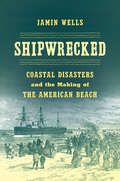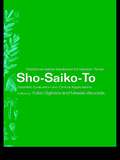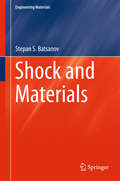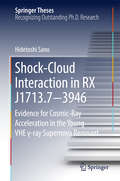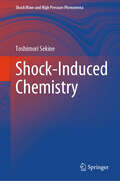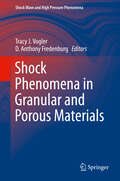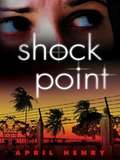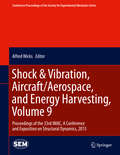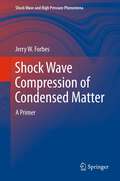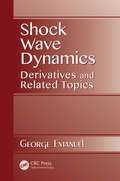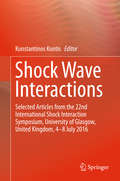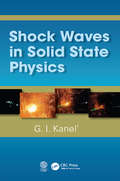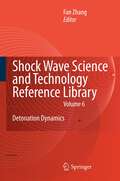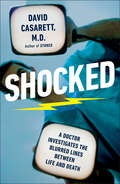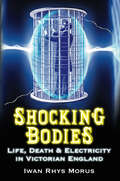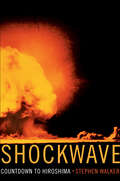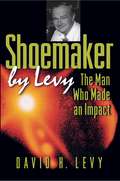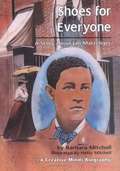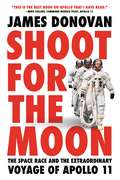- Table View
- List View
Shipwrecked: Coastal Disasters and the Making of the American Beach
by Jamin WellsReframing the American story from the vantage point of the nation's watery edges, Jamin Wells shows that disasters have not only bedeviled the American beach--they created it. Though the American beach is now one of the most commercialized, contested, and engineered places on the planet, few people visited it or called it home at the beginning of the nineteenth century. By the twentieth century, the American beach had become the summer encampment of presidents, a common destination for millions of citizens, and the site of rapidly growing beachfront communities. Shipwrecked tells the story of this epic transformation, arguing that coastal shipwrecks themselves changed how Americans viewed, used, and inhabited the shoreline.Drawing on a broad range of archival material--including logbooks, court cases, personal papers, government records, and cultural ephemera--Wells examines how shipwrecks laid the groundwork for the beach tourism industry that would transform the American beach from coastal frontier to oceanfront playspace, spur substantial state and private investment alongshore, reshape popular ideas about the coast, and turn the beach into a touchstone of the American experience.
Shivers Down Your Spine: Cinema, Museums, and the Immersive View (Film and Culture Series)
by Alison GriffithsFrom the architectural spectacle of the medieval cathedral and the romantic sublime of the nineteenth-century panorama to the techno-fetishism of today's London Science Museum, humans have gained a deeper understanding of the natural world through highly illusionistic representations that engender new modes of seeing, listening, and thinking. What unites and defines many of these wondrous spaces is an immersive view-an invitation to step inside the virtual world of the image and become a part of its universe, if only for a short time.Since their inception, museums of science and natural history have mixed education and entertainment, often to incredible, eye-opening effect. Immersive spaces of visual display and modes of exhibition send "shivers" down our spines, engaging the distinct cognitive and embodied mapping skills we bring to spectacular architecture and illusionistic media. They also force us to reconsider traditional models of film spectatorship in the context of a mobile and interactive spectator. Through a series of detailed historical case studies, Alison Griffiths masterfully explores the uncanny and unforgettable visceral power of the medieval cathedral, the panorama, the planetarium, the IMAX theater, and the science museum. Examining these structures as exemplary spaces of immersion and interactivity, Griffiths reveals the sometimes surprising antecedents of modern media forms, suggesting the spectator's deep-seated desire to become immersed in a virtual world. Shivers Down Your Spine demonstrates how immersive and interactive museum display techniques such as large video displays, reconstructed environments, and touch-screen computer interactives have redefined the museum space, fueling the opposition between public and private, science and spectacle, civic and corporate interests, voice and text, and life and death. In her remarkable study of sensual spaces, Griffiths explains why, for centuries, we keep coming back for more.
Sho-Saiko-To: Scientific Evaluation and Clinical Applications (Traditional Herbal Medicines For Modern Times Ser. #Vol. 4)
by Yukio Ogihara Masaki AburadaKampo medicine is a traditional medicine that originated from China over two thousand years ago. It was adopted by the Japanese and remained there for many years until modern times. Kampo medicine is now becoming increasingly recognized as an important therapeutic method alongside Western practice. In Japan itself, every principal hospital uses Kam
Shock and Materials: Modification And Synthesis Under High-pressure Shock Compression (Shock Wave And High Pressure Phenomena Ser.)
by Stepan S. BatsanovThis book highlights how the properties and structure of materials are affected by dynamic high pressures generated by explosions, projectile impacts, laser compression, electric discharge or ball milling. Starting with the basics of shock-wave physics and an outline of experimental techniques, it then surveys dynamic compressibility and equations of state of various substances, phase transitions and syntheses of novel compounds under shock. It covers various industrial applications including hardening of metals and grinding (fragmentation) of solids, saturation of solids with defects for use as catalysts, production of superhard materials (synthetic diamond, BN (boron nitride)) and nanomaterials, especially nanodiamond, and discusses state-of-the-art techniques such as combining dynamic and static compression to obtain monolithic materials.
Shock-Cloud Interaction in RX J1713.7−3946
by Hidetoshi SanoThis book presents a study of the young supernova remnant RX J1713. 7-3946 in order to reveal the origin of cosmic rays in our galaxy. The study focuses on the X-ray and gamma radiation from the cosmic ray electrons and protons in the supernova remnant as well as the emission from the surrounding interstellar gas measured by the NANTEN2 4-m radio telescope at Nagoya University. The gamma rays show a good spatial correspondence with the interstellar gas, which for the first time provides strong evidence of the acceleration of cosmic ray protons. Additionally, the author determines that an interaction between the supernova shockwaves and interstellar gas, referred to as "shock-cloud interaction," promotes the efficient acceleration of cosmic ray electrons in the supernova remnant. The book reveals that the interstellar gas plays an essential role in producing the high-energy radiation and cosmic rays, offering vital new insights into the origin and behavior of galactic cosmic rays.
A Shock-Fitting Primer (Chapman & Hall/CRC Applied Mathematics & Nonlinear Science)
by Manuel D. SalasA defining feature of nonlinear hyperbolic equations is the occurrence of shock waves. While the popular shock-capturing methods are easy to implement, shock-fitting techniques provide the most accurate results. A Shock-Fitting Primer presents the proper numerical treatment of shock waves and other discontinuities. The book begins by recounting the events that lead to our understanding of the theory of shock waves and the early developments related to their computation. After presenting the main shock-fitting ideas in the context of a simple scalar equation, the author applies Colombeau’s theory of generalized functions to the Euler equations to demonstrate how the theory recovers well-known results and to provide an in-depth understanding of the nature of jump conditions. He then extends the shock-fitting concepts previously discussed to the one-dimensional and quasi-one-dimensional Euler equations as well as two-dimensional flows. The final chapter explores existing and future developments in shock-fitting methods within the framework of unstructured grid methods.Throughout the text, the techniques developed are illustrated with numerous examples of varying complexity. On the accompanying downloadable resources, MATLAB® codes serve as concrete examples of how to implement the ideas discussed in the book.
Shock Focusing Phenomena: High Energy Density Phenomena And Dynamics Of Converging Shocks (Shock Wave And High Pressure Phenomena Ser.)
by Veronica Eliasson Nicholas ApazidisOne of the main reasons for continuing interest in shock focusing is its ability to concentrate energy in a small volume and produce extreme temperatures and pressures in fluids in a controlled laboratory environment. The phenomenon of shock wave focusing leading to extreme conditions in fluids during micro- and nanosecond time intervals is a spectacular example of mechanics at small length and time scales revealing the major properties of shock dynamics including high-temperature gas phenomena. Production of high-energy concentrations in gases and fluids with star-like temperatures and extreme pressures by means of a stable imploding shock is of great interest not only in its own right but also because of the connection to a multitude of phenomena in nature, technology and medicine.
Shock-Induced Chemistry (Shock Wave and High Pressure Phenomena)
by Toshimori SekineThis book begins with the history and background of the subject and then describes key experimental methods. Subsequent chapters are devoted to individual topics of chemistry and materials, namely, synthesis of hard materials, ceramics at high pressure, shock-induced chemical operations, biomolecules, meteorites, and metals and molecules under extreme conditions. Lastly, it offers applications to earth and planetary science and ends with future perspectives. Shock waves dynamically produce high pressure and temperature conditions and offer interesting areas for studies on unique chemical reactions. This book introduces readers to modern shock-induced chemistry and its applications and provides an update of topics in that discipline. Readers can gain a comprehensive understanding of current shock-induced chemistry and its versatile applications.
Shock Phenomena in Granular and Porous Materials (Shock Wave and High Pressure Phenomena)
by Tracy J. Vogler D. Anthony FredenburgGranular forms of common materials such as metals and ceramics, sands and soils, porous energetic materials (explosives, reactive mixtures), and foams exhibit interesting behaviors due to their heterogeneity and critical length scale, typically commensurate with the grain or pore size. Under extreme conditions of impact, granular and porous materials display highly localized phenomena such as fracture, inelastic deformation, and the closure of voids, which in turn strongly influence the bulk response. Due to the complex nature of these interactions and the short time scales involved, computational methods have proven to be powerful tools to investigate these phenomena. Thus, the coupled use of experiment, theory, and simulation is critical to advancing our understanding of shock processes in initially porous and granular materials. This is a comprehensive volume on granular and porous materials for researchers working in the area of shock and impact physics. The book is divided into three sections, where the first presents the fundamentals of shock physics as it pertains to the equation of state, compaction, and strength properties of porous materials. Building on these fundamentals, the next section examines several applications where dynamic processes involving initially porous materials are prevalent, focusing on the areas of penetration, planetary impact, and reactive munitions. The final section provides a look at emerging areas in the field, where the expansion of experimental and computational capabilities are opening the door for new opportunities in the areas of advanced light sources, molecular dynamics modeling, and additively manufactured porous structures. By intermixing experiment, theory, and simulation throughout, this book serves as an excellent, up-to-date desk reference for those in the field of shock compression science of porous and granular materials.
Shock Point
by April HenryCassie discovers that her stepfather, Rick, a teen psychiatrist, has been illegally prescribing a new behavioral drug to his patients?and three teens have died. Before she can report him, Rick commits Cassie to Peaceful Cove, a boot camp for troubled teens in Mexico. Cassie knows she has to get out now, before more teens die. But no one has ever escaped from Peaceful Cove alive?and even if Cassie gets over the walls and survives the Mexican desert, will anyone believe her story? .
Shock & Vibration, Aircraft/Aerospace, and Energy Harvesting, Volume 9
by Alfred WicksShock & Vibration, Aircraft/Aerospace, Energy Harvesting, Volume 9: Proceedings of the 33rd IMAC, A Conference and Exposition on Structural Dynamics, 2015, the ninth volume of ten from the Conference brings together contributions to this important area of research and engineering. The collection presents early findings and case studies on fundamental and applied aspects of Shock & Vibration, Aircraft/Aerospace , Energy Harvesting, including papers on: Energy Harvesting Adaptive Support Shock Calibration Operating Data Applications
Shock Wave Compression of Condensed Matter: A Primer
by Jerry W ForbesThis book introduces the core concepts of the shock wave physics of condensed matter, taking a continuum mechanics approach to examine liquids and isotropic solids. The text primarily focuses on one-dimensional uniaxial compression in order to show the key features of condensed matter's response to shock wave loading. The first four chapters are specifically designed to quickly familiarize physical scientists and engineers with how shock waves interact with other shock waves or material boundaries, as well as to allow readers to better understand shock wave literature, use basic data analysis techniques, and design simple 1-D shock wave experiments. This is achieved by first presenting the steady one-dimensional strain conservation laws using shock wave impedance matching, which insures conservation of mass, momentum and energy. Here, the initial emphasis is on the meaning of shock wave and mass velocities in a laboratory coordinate system. An overview of basic experimental techniques for measuring pressure, shock velocity, mass velocity, compression and internal energy of steady 1-D shock waves is then presented. In the second part of the book, more advanced topics are progressively introduced: thermodynamic surfaces are used to describe equilibrium flow behavior, first-order Maxwell solid models are used to describe time-dependent flow behavior, descriptions of detonation shock waves in ideal and non-ideal explosives are provided, and lastly, a select group of current issues in shock wave physics are discussed in the final chapter.
Shock Wave Dynamics: Derivatives and Related Topics
by George EmanuelWorking knowledge of the relations of various quantities and their derivatives across a shock wave is useful for any advanced research involving shock waves. Although these relations can be derived in principle by any diligent student of the subject, the derivations are often not trivial, and once derived, neither the approach nor the result can be
Shock Wave Interactions: 22nd International Shock Interaction Symposium
by Konstantinos KontisThis edited monograph contains the proceedings of the International Shock Interaction Symposium, which emerged as an heir to both the Mach Reflection and Shock Vortex Interaction Symposia. These scientific biannual meetings provide an ideal platform to expose new developments and discuss recent challenges in the field of shock wave interaction phenomena. The goal of the symposia is to offer a forum for international interaction between young and established scientists in the field of shock and blast wave interaction phenomena. The target audience of this book comprises primarily researchers and experts in the field of shock waves, but the book may also be beneficial for young scientists and graduate students alike.
Shock Wave–Boundary-Layer Interactions
by John K. Harvey Holger BabinskyShock wave-boundary-layer interaction (SBLI) is a fundamental phenomenon in gas dynamics that is observed in many practical situations, ranging from transonic aircraft wings to hypersonic vehicles and engines. SBLIs have the potential to pose serious problems in a flowfield; hence they often prove to be a critical - or even design limiting - issue for many aerospace applications. This is the first book devoted solely to a comprehensive, state-of-the-art explanation of this phenomenon. It includes a description of the basic fluid mechanics of SBLIs plus contributions from leading international experts who share their insight into their physics and the impact they have in practical flow situations. This book is for practitioners and graduate students in aerodynamics who wish to familiarize themselves with all aspects of SBLI flows. It is a valuable resource for specialists because it compiles experimental, computational and theoretical knowledge in one place.
Shock Waves in Solid State Physics
by G. I. Kanel'Methods and the latest results of experimental studies of the strength properties, polymorphism and metastable states of materials and substances with extremely short durations of shock-wave action are presented. The author provides a comprehensive and theoretical description of specific features of the dynamics of elastoplastic shock compression waves in relaxing media. The presentation is preceded by a detailed description of the theoretical foundations of the method and a brief discussion of the basic methods of generating and diagnosing shock waves in solids. Key Selling Features: Addresses dynamic elastic-plastic response, spallation, and shock-induced phase transformation. Provides a centralized presentation of topics of interest to the shock physics community Presents new data on the mechanism and basic patterns of sub-microsecond polymorphic transformations and phase transitions. Investigates destruction waves in shock-compressed glasses. Analyzes the behavior of highly hard brittle materials under shock-wave loading and ways to diagnose fracture.
Shock Waves Science and Technology Library, Vol. 6
by F. ZhangThis book, as a volume of the Shock Wave Science and Technology Reference Library, is primarily concerned with the fundamental theory of detonation physics in gaseous and condensed phase reactive media. The detonation process involves complex chemical reaction and fluid dynamics, accompanied by intricate effects of heat, light, electricity and magnetism - a contemporary research field that has found wide applications in propulsion and power, hazard prevention as well as military engineering. The seven extensive chapters contained in this volume are: - Chemical Equilibrium Detonation (S Bastea and LE Fried) - Steady One-Dimensional Detonations (A Higgins) - Detonation Instability (HD Ng and F Zhang) - Dynamic Parameters of Detonation (AA Vasiliev) - Multi-Scaled Cellular Detonation (D Desbordes and HN Presles) - Condensed Matter Detonation: Theory and Practice (C Tarver) - Theory of Detonation Shock Dynamics (JB Bdzil and DS Stewart) The chapters are thematically interrelated in a systematic descriptive approach, though, each chapter is self-contained and can be read independently from the others. It offers a timely reference of theoretical detonation physics for graduate students as well as professional scientists and engineers.
Shocked
by David CasarettNot too long ago, there was no coming back from death. But now, with revolutionary medical advances, death has become just another serious complication. As a young medical student, Dr. David Casarett was inspired by the story of a two-year-old girl named Michelle Funk. Michelle fell into a creek and was underwater for over an hour. When she was found she wasn't breathing, and her pupils were fixed and dilated. That drowning should have been fatal. But after three hours of persistent work, a team of doctors and nurses was able to bring her back. It was a miracle. If Michelle could come back after three hours of being dead, what about twelve hours? Or twenty-four? What would it take to revive someone who had been frozen for one thousand years? And what does blurring the line between "life" and "death" mean for society? In Shocked, Casarett chronicles his exploration of the cutting edge of resuscitation and reveals just how far science has come. He begins in the eighteenth century, when early attempts at resuscitation involved public displays of barrel rolling, horseback riding (sort of), and blowing smoke up the patient's various orifices. He then takes us inside a sophisticated cryonics facility in the Arizona desert, a darkroom full of hibernating lemurs in North Carolina, and a laboratory that puts mice into a state of suspended animation. The result is a spectacular tour of the bizarre world of doctors, engineers, animal biologists, and cryogenics enthusiasts trying to bring the recently dead back to life. Fascinating, thought-provoking, and (believe it or not) funny, Shocked is perfect for those looking for a prequel--and a sequel--to Mary Roach's Stiff, or for anyone who likes to ponder the ultimate questions of life and death.
Shocking Bodies: Life, Death and Electricity in Victorian England
by Iwan Rhys MorusFor the Victorians, electricity was the science of spectacle and of wonder. It provided them with new ways of probing the nature of reality and understanding themselves. Luigi Galvani's discovery of 'animal electricity' at the end of the eighteenth century opened up a whole new world of possibilities, in which electricity could cure sickness, restore sexual potency and even raise the dead. In Shocking Bodies, Iwan Rhys Morus explores how the Victorians thought about electricity, and how they tried to use its intimate and corporeal force to answer fundamental questions about life and death. Some even believed that electricity was life, which brought into question the existence of the soul, and of God, and provided arguments in favour of political radicalism. This is the story of how electricity emerged as a powerful new tool for making sense of our bodies and the world around us.
Shockwave: Countdown to Hiroshima
by Stephen WalkerA riveting, minute-by-minute account of the World War II bombing of Hiroshima, from early testing to the cataclysmic event and its aftermath.On a quiet Monday morning in August 1945, a five-ton bomb—dubbed Little Boy by its creators—was dropped from an American plane onto the Japanese city of Hiroshima. On that day, a firestorm of previously unimagined power was unleashed on a vibrant metropolis of 300,000 people, leaving one third of its population dead, its buildings and landmarks incinerated. It was the terrifying dawn of the Atomic Age, spawning decades of paranoia, mistrust, and a widespread and very real fear of the potential annihilation of humanity.Author Stephen Walker brilliantly recreates the three terrible weeks leading up to the wartime detonation of the atomic bomb—from the first successful test in the New Mexico desert to the cataclysm and its aftermath—presenting the story through the eyes of the pilots, scientists, civilian victims, and world leaders who stood at the center of earth-shattering drama. It is a startling, moving, frightening, and remarkable portrait of an extraordinary event—a shockwave whose repercussions can be felt to this very day.
Shoemaker by Levy: The Man Who Made an Impact
by David H. LevyIt was a lucky twist of fate when in the early1980s David Levy, a writer and amateur astronomer, joined up with the famous scientist Eugene Shoemaker and his wife, Carolyn, to search for comets from an observation post on Palomar Mountain in Southern California. Their collaboration would lead to the 1993 discovery of the most remarkable comet ever recorded, Shoemaker-Levy 9, with its several nuclei, five tails, and two sheets of debris spread out in its orbit plane. A year later, Levy would be by the Shoemakers' side again when their comet ended its four-billion-year-long journey through the solar system and collided with Jupiter in the most stunning astronomical display of the century. Not only did this collision revolutionize our understanding of the history of the solar system, but it also offered a spectacular confirmation of one scientist's life work. As a close friend and colleague of Shoemaker (who died in 1997 at the age of 69), Levy offers a uniquely insightful account of his life and the way it has shaped our thinking about the universe. Early in his training as a geologist, Shoemaker suspected that it wasn't volcanic activity but rather collisions with comets and asteroids that created most of the craters on the moon and most other bodies in the solar system. Convincing the scientific community of the plausibility of "impact theory," and revealing its power for penetrating mysteries such as the extinction of the dinosaurs and the timing of the Earth's eventual demise, became Shoemaker's mission. Through conversations with Shoemaker and his family, Levy reconstructs the journey that began with a young geologist's serious desire to go to the moon in the late1940s. Sent by the government to find a way to harvest plutonium, Shoemaker instead found evidence in desert craters for what became his impact theory. While he never became an astronaut, he did become the first geologist hired by NASA and subsequently set the research agenda for the first manned lunar landing. After a series of victories and setbacks for Shoemaker, the collision of Shoemaker-Levy 9 with Jupiter provided the most convincing proof to date of the role of impacts in our solar system. Levy's explanation of the scientific reasoning that guided Shoemaker in his career up to this dramatic point--as well as his personal portrait of a man who found white-water rafting to be an easy way to relax--sets these fascinating events in a human scale. This biography shows what Shoemaker's legacy will be for our understanding of the story of the Earth well into the twenty-first century.
Shoes for Everyone: A Story about Jan Matzeliger
by Barbara MitchellA biography of the half-Dutch/half-black Surinamese man who, despite the hardships and prejudice he found in his new Massachusetts home, invented a shoe-lasting machine that revolutionized the shoe industry in the late nineteenth century.
Shoot for the Moon: The Space Race and the Extraordinary Voyage of Apollo 11
by James Donovan"This is the best book on Apollo that I have read. Extensively researched and meticulously accurate, it successfully traces not only the technical highlights of the program but also the contributions of the extraordinary people who made it possible." -Mike Collins, command module pilot, Apollo 11When the alarm went off forty thousand feet above the moon's surface, both astronauts looked down at the computer to see 1202 flashing on the readout. Neither of them knew what it meant, and time was running out...ON JULY 20, 1969, Neil Armstrong and Buzz Aldrin became the first humans to walk on the moon. One of the world's greatest technological achievements-and a triumph of American spirit and ingenuity-the Apollo 11 mission was a mammoth undertaking involving more than 410,000 men and women dedicated to winning the space race against the Soviets. Set amid the tensions of the Cold War and the upheavals of the sixties, and filled with first-person, behind-the-scenes details, Shoot for theMoon is a gripping account of the dangers, the challenges, and the sheer determination that defined not only Apollo 11, but also the Mercury and Gemini missions that came before it. From the shock of Sputnik and the heart-stopping final minutes of John Glenn's Mercury flight to the deadly whirligig of Gemini 8, the doomed Apollo 1 mission, and that perilous landing on the Sea of Tranquility-when the entire world held its breath while Armstrong and Aldrin battled computer alarms, low fuel, and other problems- James Donovan tells the whole story. Both sweeping and intimate, Shoot for the Moon is "a powerfully written and irresistible celebration" (Booklist, starred review) of one of humankind's most extraordinary feats of exploration.
Shoot the Moon: Shoot the Moon
by Dupont-Bloch NicolasThe Moon boasts an unexpected variety of landscapes - including volcanic features, sinuous valleys and ghost craters - which are readily visible from Earth. This practical guide explains and demonstrates how you can capture impressive images of our nearest neighbour in space using a variety of different techniques. As the first guide to be dedicated to modern lunar imaging, this volume offers an in-depth and illustrated approach to common optics, the essentials of digital images, imaging devices, and image processing software. Even in light-polluted areas, the countless features and finest details of the Moon can be captured by following the instructions in this comprehensive and accessible guide. Covering equipment ranging from smartphones and DSLRs to specialist planetary cameras, whether you are a novice without a telescope, an amateur developing your skills in imaging, or an experienced astrophotographer, you will benefit from the hints, insights and expertise within.
Shooter's Bible Guide to Handloading: A Comprehensive Reference for Responsible and Reliable Reloading
by Wayne Van ZwollA thorough resource on handloading at home, Shooter’s Bible Guide to Handloading provides detailed information about the history of handloading and key figures’ innovations, a simple explanation of hand reloading, selecting the basic tools needed, and choosing your cases, dies, primers, and powders as well as step-by-step instructions for reloading firearm cartridges and how to test your loads at the range. The text is supplemented by more than one hundred detailed photographs that illustrate the various types of reloading equipment available and provide guidance in performing the actions that result in a handloaded cartridge. The Shooter’s Bible Guide to Handloading covers interesting engineering questions the handloader may consider, including bullet integrity, copper bullets, and energy versus killing power. Other topics covered include: Handloading the old-fashioned way Casting your own bullets The influence of barrel length Economics of home reloading And much more! Pick up a copy of the Shooter’s Bible Guide to Handloading to learn everything you need to know about reloading by hand at home.
